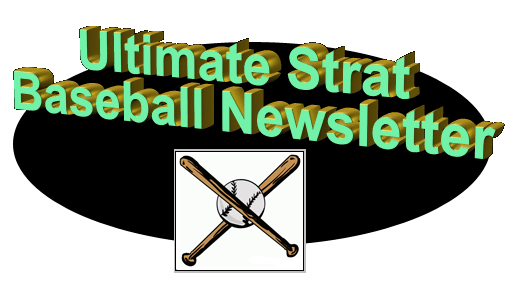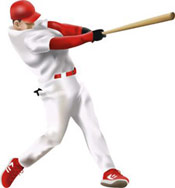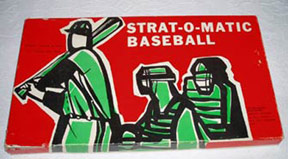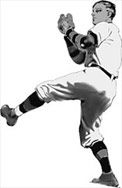Vol. IV,
Issue #6- August 2016
**
Field of Dreams - the Movie and
Book --
Part II of the Report by Wolfman Shapiro
Comparison of the Story in the Book to the Film
**
(We all loved the movie and the great performances by the
actors but how close is the
story presented in the film to the story written by W. P.
Kinsella in his book "Shoeless Joe"?)
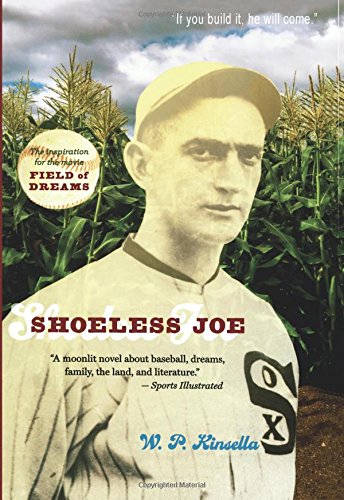
(Notes from the Wolfman:
In
this part of the second phase on my report that is linked to the
Baseball Field at the farm in Dryersville, Iowa that was used for the
film, "Field of Dreams". Plus, the information related to the author
of the book the film was based upon called, "Shoeless Joe" by W. P. Kinsella, I will
be discussing the differences between the story told in the book
and the movie as there were some quite significant differences. But if you read part 2
of the interview with Mr. Kinsella shared in this current issue
of the newsletter; he did say, he didn't mind
what the movie producer did to bring his story alive. During August, I was able to
get a copy of the Mr. Kinsella's book through my local library so I could see
what the real story was, as I was curious.
Now, here is some information
that is related to the book version. I am taking this information from the
copy I have. On the cover (see illustration above) besides
showing a photo of "Shoeless Joe Jackson" in his
White Sox uniform in front of a corn field, above his head it
shows the famous line -- "if you build it, he will come."
Then in a circle by his head it states - "The Inspiration or the
movie, FIELD of DREAMS" and the quote shown on the cover is from
Sports Illustrated - "A moonlit novel about baseball, dreams,
family, the land, and literature."
The book was originally
published in 1982, although the story takes place in 1979.
On the title page of this version of the book it states "Winner
of a Houghton Mifflin Literary Fellowship Award". The book
is then divided into Five Parts or Sections and is 265 pages
long, there are no illustrations. It is written in first
person from the perspective of Ray Kinsella (the owner of the
farm played by Kevin Kostner) and sometimes in third person.
So dear friends, below is my summary of my comparison of the
story written by W. P. Kinsella against how it was dramatized in the move and
I focus on the different story points. I am assuming that at the very minimum you
have watched the movie so you will know about the parts of the
story and the characters I am speaking about in particular ... enjoy ...
"Shoeless Joe" vs. the "Field of Dreams"
as interpreted by Wolfman Shapiro
About the Characters in the
Story:
If you read part I of this report from last month's issue, I
gave a brief summary of the main characters in the story from the movie
perspective, but in this article I will
mention them by their names in the story.
The characters who are the
same in the book as in the movie include: Ray, Annie and Karin Kinsella, who own the farm in
Iowa where the baseball field is created. Mark is Annie's
brother and is involved with buying and selling property and acquiring farm lands.
There is mention of Annie's mother but she doesn't show up in
the book. Of course, all of the 8 ghost baseball players
from the 1919 Chicago White Sox are present including
"Shoeless Joe Jackson" and of course we have Doc Graham or
Moonlight Graham - the two versions including his older and younger self and
of course Ray's father, John Kinsella (who is talked about a lot
but we only see as a ghost baseball player).
One character had to be
completely revised for the movie however, as this is explain in the historical notes
article I have included
in another section of this report for this issue is the
character who is shown as an author that Ray goes to meet and
bring back to the Baseball Field. In Kinsella's book, his name
is J. D. ("Jerry") Salinger who is based upon a real person who
was a famous author and known for the book, "The Catcher in the
Rye" which was written in 1951. This book dealt with baseball
too.
Mr. Salinger died in 2010. As is noted in my historical
notes the real Salinger threatened to sue the production company if he was
portrayed in the film. Therefore, since he was such an important
and key character for the story, they created a new character named
Terrence Mann who was also an author but known as a peace writer
and protestor of the 1960's.
In the book, W.P. Kinsella showed Mr.
Salinger living in New Hampshire, whereas Mr. Mann lived in
Boston. This is the city where Ray took this character to a baseball game.
Both of these characters did write an article about how they
wished, when they were younger, they could have played
professional baseball and loved
baseball as well as were sad when their favorite team moved to
California and their stadium was demolished. However for
Salinger it was the New York Giants at the Polo Grounds and for
Mann it was the Brooklyn Dodgers (probably because he was black
and the Dodgers brought in Jackie Robinson) and Ebbets Field
that was
closed. We also meet the same woman who works at the newspaper
in Chisholm, Minnesota, the city where Doc Graham lived.
There are several new
characters we see in the story which we do not see in the film.
This includes Ray's twin brother Richard and his girl friend
Gypsy, as they come through the area where the farm is located in Iowa
City as part of a circus. Richard like Ray leaves his home
when he is quite young and wanders the world. The brothers
don't seem to have much contact for a while with each other but Richard says he
is innerwardly driven to find Ray during the time of the story.
In the film, Annie's
brother Mark comes with two business partners but in the story
they only show one business partner named Bluestein, his
accountant. In the book, the person who owned the farm before Ray and
Annie bought it from him, his name is Eddie Scissions, and he claims to be the oldest
living Chicago Cub. What this means is that he claims he played on
the 1908-1910 Chicago Cubs (1908 being the last season the Cubs won the world series).
However, we learn later that Eddie never made it to the majors,
that he
only played in the minor leagues but Ray goes along with his
fantasy. When Eddie's character dies near the end of the story,
he is buried in an Old Chicago Uniform on the baseball field on
the farm. We meet briefly Eddie's ex-wife and his three daughters. There is no mention of a
sister that Annie has however in the book.
Differences between the Story in the Book and the Film:
There are quite a number of differences between the story in the
book and what we saw in the film. In general, since you usually
only have 2 hours or so to tell a story, the film has to be more
condensed. And this is true also for Kinsella's book as there are quite a few parts of the story we don't see
besides the characters I mentioned above. However, I believe,
and in my opinion, that whoever wrote the script, he/she actually enhanced the story
as some parts of the book for me (even with my paranormal
beliefs) were a bit hazy and were left to the reader's imagination.
Anyway, in this section you will see what I mean by this last
comment.
A Key Concept:
In the movie, we see a
whole baseball field that Ray built and it appears all the ghost
baseball players who
appear, that for those people who can see these players, they
appear to be very real people they can touch and see, who also have the personality of this
person/player when he was alive. However, in the story we hear
about two type of ghosts linked to the baseball field: a) ones
who seem to be like real people you can speak to and; b) other
players, people in the stands, food sellers, the announcer of
the games that are being played, that are less real and more misty like
or ethereal - but
these elements are necessary so when the games go on - the
people watching them see a full game played out in every aspect
as if you were at a real baseball game played at a ballpark
today.
The Voice:
In both the story and the movie we hear a spirit like voice
which Ray hears and also the character Salinger/Mann hears.
In the book, the voice sounds like a Baseball Announcer, in the
film we are not sure who it is but it does sound like the voice
of "Shoeless Joe" or the actor who plays him.
The Baseball Field:
In the movie, Ray creates the whole baseball field, plowing out
his corn crop before "Shoeless Joe" shows up including
installing lights. He only makes a wooden bleacher for
people to sit and watch the game on the 1st base side. The
outfield is defined at the edge by the corn field. However
in the story, Ray only creates enough of the field so that there
is a home plate and left field. This is because he already knows
"Shoeless Joe", his father's favorite baseball player is going
to show up and he is preparing everything for him when "Shoeless
Joe" arrives. Then,
"Shoeless Joe" plays full games with other misty or
phantom players. In the story, in the field portrayed in
this version, Ray has
created a fence at the left field edge and then there are bleachers
which are
behind left field. So Ray's initial conversation with
"Shoeless Joe", which is similar to what we see in the movie is
conducted from the bleachers and he doesn't hit the ball to him
or pitch to him this first time when they meet.
In the story as Ray creates
more of the baseball field then the other 1919 White Sox who
were banned from the game (due to being paid off by gamblers to
lose the world series) begin to show up for example at 3B and SS
and so on. What is not clear from the story is if Ray ever
finishes completely making the full baseball field because the aspects
which are not completed stay in the misty phantom form. It
is obvious, it would be difficult to show this aspect of the
book in the movie so it
was just eaiser to have Ray build the whole field first.
The Doorway to Heaven in
Center Field: In the
movie, we see the Ball Players going into Center Field and
walking into the corn field there and disappearing - moving into
what they call Heaven or another dimension. In the story, there
is a Gate or Door in Center Field that the players come in and
out - it is only discussed in the last part of the book and has
a silver latch to open and close it which Ray's family must
release to allow the ghost people come in. Kinsella states in the
book, the players who have substance and those without, all go
together through
this door to come and go from the field. Additionally when the door is
closed and everyone leaves the field, the lights to the stadium
automatically go out or when the players show up, the lights go
on. Also the ghost players talk a little bit
of what it like from where they come from, like a heaven in the
film but in the story this isn't very much discussed at all -
Ray speculates is it a place where time stops and everything
seems to be frozen or in a null state.
Archie "Doc" Graham / Archie "Moonlight" Graham:
This character is
portrayed
the same in both the book and the film but there are a few difference.
In
the book when Ray and Jerry are leaving Chisholm, they pick up
the younger version of the Doc at the edge of the city whereas this happens
in the movie somewhere along the road or highway. Then when they all arrive at the
farm in Iowa, Moonlight Graham appears as a living person who is
interacting with Ray's family in their house and sleeping there
along with Jerry and later Eddie Scissions
stays at the farm as well. Even Mark, Annie's brother sees Moonlight
as a real person because when "Shoeless Joe" asks Archie if he
is ready to play in the game, as soon as Archie goes on the
field, he disappears for Mark, who can't see the games going on.
Archie actually stays with the family for several days before he
becomes a ghost ballplayer. Another difference is, in real
life "Moonlight" Graham played for the New York Giants but instead of taking
on a Giants uniform as he
does in the film, he is given an old White Sox uniform and plays right
field for this team. In the story, in his first at bat
he flies out like in the movie but he does not knock in the runner
from third base.
Further, when Karen is sitting
in the bleachers watching the game and gets a hot dog caught in her throat and
then falls to the ground, starting to turn blue, which is due in
part to an
argument between Mark and Ray and Annie about the future of the
farm, in the movie when Moonlight Graham becomes Doc Graham, he
changes into his older self as he crosses the edge of the baseball field but in the
story he makes this transformation while he is still on the
field. Also we don't have in the story when Doc appears, that
then
Mark can see the baseball players and tells Ray and Annie not to
sell the farm, Mark makes no such comment.
The Gun:
In the film, to get Terrence
Mann to go to the Red Sox Game in Boston, Ray used his hand in
his coat pocket pretending to have a gun which he didn't have but in the book, Ray is
inspired to buy a gun before he leaves to meet Mr. Salinger, but he does not use it to convince Salinger
to go with him (using verbal persuasion although the gun is in
his car) to the Redsox Game. Ray does use the gun later in
the story when Mark and Bluestein
(near the end of the book) threaten to take the farm from him,
because they acquired the note on the farm and Ray takes out his
gun and threatens them if they don't leave the field.
The Vision to Save the Farm:
In the film, near the end, Mark
tells Ray he has to sell the farm to them (handing him an
envelope) as he is way behind on the mortgage, and has no choice
(but Mark does tell Ray that he and his family
will be able to live in the house rent free) -- just as Ray
believes he must accept then Karin tells him that he doesn't have to
sell the farm because
people will come to the field to see the game. Then
Terrence Mann agrees and go into his long speech about how
important baseball is for our nation. However, in the story,
Salinger is the only one who speaks about people coming to the
baseball field, as he has a dream about it and see it. Then, just
as he finish his little speech cars start showing up. In the film
the people don't arrive in cars until Mann has gone out with the "ghost players"
to wherever they go and Ray
meets his father as the catcher and they talk and then do a
catch, for which then we see all these cars
driving up to the farm - hundreds of them.
Ray's father John, a catcher
in the game - the meaning of "if you build it, he will come":
In the film, we don't
know that Ray's father is on the field till the end, as before
"Shoeless Joe" leaves the field for the game, he repeats this
famous line to Ray with his head moving toward his father as we
are led to believe the true meaning of why the
field was built was so Ray had a chance to re-meet his father as
a "ghost player". Because in the movie, after Ray left his home
during an argument with his father, Ray says his father passed away before he could
apologize for the disagreement and perhaps not respecting him. We are led to believe
initially that Ray built the field to
bring "Shoeless Joe" back. However, in the story, Ray
knows quite early that his father is going to come back as the
catcher and keeps asking if the catcher has shown up. They have to wait awhile for this to
actually happen and then for one game, the name of
his father is announced catching for the White Sox (although in
real life, his
father was just a minor league player and never made it to the
majors). Even after Ray knows his father is catching in the
story, he just can't go up
and talk to him. Near the end of the story he eventually does with
Annie and Karin and his brother Richard and his girlfriend, all
go to see his dad. But
then they don't play catch with all the cars coming to the
field and the conversation they have is very brief. One of the key aspects
for the current owner of the Field
of Dreams Baseball Field is the idea of people coming here to
play catch which was popularized by the movie and not the story.
Going out with the Players:
In the film, as "Shoeless
Joe" is getting ready to leave, near the end of the film, he
asks a living person (while speaking to Ray and Terence) to go out with the players. First Ray thinks its
him but then "Shoeless Joe" points at Terence Mann. In the
story in the book, "Shoeless Joe" and another of the White Sox
Player are
talking to Salinger in the Outfield when they ask him if he
wants to go with them. In the
movie and the book, Ray gets upset initially as he feels since
he built the field it should be him but eventually accepts the
comments from the
Mann/Salinger character why they are the one being called to go "OUT" with the
players and will write about their experience (although in the story it is
speculated that Salinger may see the "Polo Grounds" out there or
see Scissions). Also in the story Salinger, "Shoeless
Joe", the other White Sox outfielder with the catcher (Ray's Dad)
are the last to leave together through the door to so-called
Heaven. Whereas, in the film after Mann goes through the
dimensional door in the corn, "Shoeless Joe" stands in front of
Ray and Annie grinning, repeats "if you build it, he will come"
and then Ray sees his father as the catcher removing his mask and goes to greet him
and introduce Annie and Karin. (Note: - I think
whoever came up with this link for the story of the film was
divinely inspired and was a genius!)
Part of the Story in the Film
which didn't happen in the book:
In
this part of the report I will share (as I have the film almost
memorized) things which were added to the movie that I didn't see in the
book.
a) In the movie, both Ray and
Annie had a dream of Ray sitting with Terence Mann at the Ball
Game at Red Sox ball park.
b) Ray asking the farmers when
he went out to get supplies for the farm, if other farmers heard
voices in the field?
c) When Ray is plowing down
his corn field to make space for the baseball field having his
neighbors drive out and watch him saying he is crazy!
d) the movie focuses more on
the other 7 White Sox ball players as they speak with Ray and
tell their story, in the book the main characters mostly have
conversations with "Shoeless Joe".
e) there really isn't a visit
to the farm by Annie's mother and sister
f) at the ball game with the
Red Sox - Ray asks Terrence Mann questions about what he has
been doing recently - and Terrence discusses why he wants to be
left alone - (in the book the questions are about if Salinger is
lonely and about the story in "Catcher in the Rye").
f2) after the baseball game
when Ray takes Mr. Mann home, to his apartment, as he turns the
car around Mann stands in front of him and share the message Ray
heard at the Red Sox park, "Go the Distance", Mann says this -
Ray asks what it means - and Mann says it means he is going with
him to Iowa. (In the story, Ray drops him off at his home in New
Hampshire and as he is leaving Salinger says, "New York Giants,
1905, one game, one inning." -- this means Salinger saw the
invoice on Moonlight Graham on the Electronic Scoreboard) - then
they have a longer discussion and Salinger said they have to go
to Minnesota.)
g) Ray meets Doc Graham in the
past some time in the 1960's, he sees him walking on the street
(this was before he passed away - however in the book he meets
Doc in 1955, outside his apartment).
h) Doc has a special office
for his practice as a physician (his office in the book is
inside a school)
i) when Annie talks to Ray
when he phones and he is coming home from Minnesota, Mark and his partners are
at their home during the call - Annie doesn't tell Ray they have
the note on the house now
j) there is no discussion of
the wooden seats be by the 1st base line (all the spectators
around the field are wispy specters' in the book)
k) there is no PTA Meeting
with Annie and Ray attending, and then Ray gets the message,
"Ease his pain ..." and knows he has to go meet Mann.
Part of the Story in the Book
which didn't happen in the Film:
a) Ray making visits to a home to
meet Eddie Scissions and buying the farm from Eddie
b) Eddie Scissions going to
the farm after Salinger (Mann) and Moonlight Graham arrive,
playing cards and talking with the others - later in the story
while Eddie is a spectator in the fans, and the White Sox ghost
players are playing the 1908 Cubs, the announcer states Eddie is
coming on the field as a
relief pitcher for the Cubs (his younger self) who is then blasted
out of the game. When Eddie dies they bury him on the
field.
c) The book talks about the
circus which Richard and Gypsey are part of, and Ray makes a
visit to the circus to speak to Gypsy about his brother.
d) The story focuses about the
Polo Grounds in New York being torn down (not about Ebbits
Field)
e) When Ray comes to meet
Salinger at his home, in New Hampshire, he gifts him a baseball
that is signed by "Shoeless Joe Jackson" to encourage him to go
to the game with him.
f) When Ray, Salinger and
Moonlight return to Iowa, the baseball field is in bad shape and
he gets everyone to help him cut the grass including the White
Sox players.
g) at the Red Sox game, Ray
collides with a steel railing going for something to drink in
the 7th inning and gets four stitches, Salinger has to drive the
car to go back to his home.
h) whenever the lights come on
by themselves on the baseball field, the ghost players are
returning for a game
Final Conclusion
Wolfman: Of course, I have watched first the movie, "Field of Dreams"
many times, to the point where I almost have memorized the lines
of all the actors and how the story goes. Then for this
issue of the newsletter (August 2016) I read the book which the movie
was based upon. It is my opinion, that whomever was
responsible to come up with the script and story of the movie, I
think they did a great job as I felt the story had a natural
flow to it. Even though they cut out some
of the characters and had to replace one, I think the movie
version of the story will make more sense to
the viewer then it will if you read the novel form. I found
sometimes the novel version was jumping around a bit too much
and I wasn't sure why W.P. Kinsella was telling certain side
stories that didn't seem to be linked to the story. Also I
am not sure if people can visualize all the ethereal people that
are present during the game, the spectators (the fans) and the
other ball players.
I didn't speak about the character's dialogues in the analysis
part of this report because there is just so many new
conversations going on in the book version but some of the
magical lines we hear in the movie do actually come directly from the
story - so we need to thank Mr. Kinsella for creating this part
of the magic. All the special messages Ray receive (the
whispering), for example, are in the story. So I don't
want to sound like I didn't enjoy Mr. Kinsella book, because the
key parts of the story which create the film are all there, just
that the film was done very well and any areas which might not
be clear to the reader in the book, the script writer(s) got it
together for the film.
I found in the book, it was a little hard again to understand what was
happening on the field and why he decided to have a kind of wispy
specters along with more solid "Ghost players" as
having
all the players and umpires being real works well I thought. In the movie it
was clear, that what the characters who were watching the games, all
the baseball players were real to them as they could speak to
them and see them. I think the
movie gave us a better chance to really know Ray's character as well as
his family (it was more believable) and also I think it was good
to have conversations and see all of the White Sox Players
interact.
In the book, the focus is on "Shoeless Joe" and the other White
Sox players we hardly heard from.
The affect of going
through a dimensional door in the corn field and vanishing
(phasing out) was a bit more interesting than going into a door
and closing it I feel. The act of vanishing is really what
happens when a person moves into another dimension and there
documented cases of this happening.
I am not sure in the story why Ray needed to have a twin brother per say
and how this helped the story. Also I would have liked to have
seen more interaction with their father in the story
in the book who was more than just the catcher. The way they
showed this relationship (Ray and
his Dad) in the movie and that they had
a catch at the end of the film was a stroke of genius along with the line of
cars with their lights on coming to the field. Finally, I think
showing the field was built for Ray to meet his father in the
film was a stroke of genius that we didn't see in the book.
So W. P. Kinsella, no doubt wrote a most interesting story that
the film could be based on but I believe those who helped the
story in the film greatly enhanced this story and were able to
build upon it. While I am sure
the book by itself would do well, there is no doubt that the
movie make it into a best seller. Also, as Mr. Kinsella said in his
interview we share in this issue that he is probably one of the few authors
who trusted the
movie people to make his story look good on the screen
and indeed they did as we know now from the film's popularity.
The book is listed on the resource page if you want to read
"Shoeless Joe" for yourself. I read it in about 3 days and I
also found other books by Mr. Kinsella, I will be reading soon.
Finally, you may want to also review the other page I setup to
augment this report, an article I found on Wikipedia that discusses
little known facts linked to how the movie was created and some
of the interesting situations that came up and challenges to get
the movie completed. To read this article just click
here.
